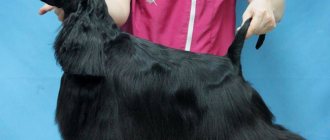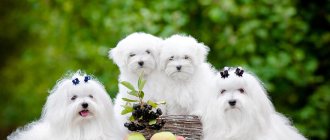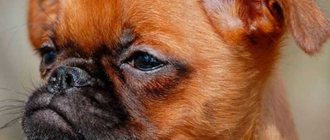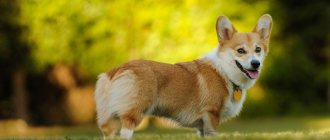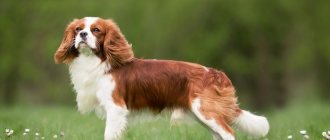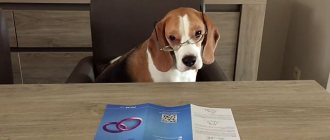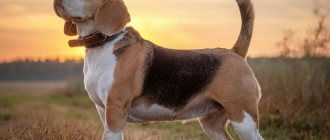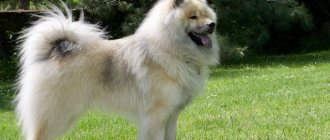Breeds
Have you heard anything about Chinooks? Hardly. This is a rare breed of Chinook dog. To those who see them for the first time, it seems that the same dog lives in the neighboring yard or runs along the street of his hometown. In fact, to form this breed, enthusiasts made considerable efforts. They crossed males and females of different breeds with each other, achieving the same type of livestock so that the breed was recognizable.
Chinooks have a certain character, they are hardy, strong and bred by people specifically to pull sleds with people and loads in a harness.
Dogs can work in extreme cold. At that time, there was a need for such powerful working dogs capable of carrying large loads. A good pace was also required from the team so that the cargo was delivered to the customer in the shortest possible time.
History of the breed
The history of the Chinook breed is quite interesting. The founding time of this breed is considered to be the 20th century. At that time, Arthur Walden was involved in the formation of the breed itself.
Due to the fact that Arthur had a favorite dog named Chinook, who served as the leader of the team. In general, in honor of this dog, Arthur came up with the name for the entire breed.
The creation of the breed was not entirely simple. Various dogs were selected to breed it. But, subsequently, the breed was still bred.
The main function of the Chinook dog breed was to lead the team. The dogs did their job well and pulled a heavy sled.
Unfortunately, this breed is not completely official, and Chinook owners will not be able to present it at special exhibitions.
Character
Chinooks, like true northerners, are calm, balanced, and wholeheartedly devoted to their owner. From the photo you can understand how sedately and impressively they behave.
Dogs that ride in sleds appreciate camaraderie and thrive in a human-dog pack.
They love to communicate and feel bad when they are forced to be alone for a long time. Pets are gentle and sensitive. They love their owner very much and are ready to follow him anywhere.
With all his sociability, the owner must become an authority for him from childhood, and earn love and respect with fair treatment. It’s great if you are an active, strong-willed person. You need to walk a lot with your Chinook and spend time together. So, he will understand that we love him.
The Chinook dog breed is very friendly. They, like huskies, are not aggressive towards people. They don't like to bark. Therefore, not everyone will take such a dog to guard their home when they need to scare away a potential burglar with their voice.
Dogs are brave. If someone threatens the owner, family members, or encroaches on property, the Chinook will quickly understand this and come to the defense. Pets are strong-willed, they show persistence in achieving goals. Strong and efficient.
Chinooks have excellent hearing and scent. They like to explore new territories or simply sniff a familiar path on walks. Dogs of this breed get along well with other pets. They love children and enjoy playing outdoor games with them. They bring them throwing balls, sticks, rubber and plastic rings.
Dog handlers use Chinooks as rescue dogs. Some dogs work with police officers, following the scent of intruders. Dogs mature later than many other breeds. In 2 years - these are dog children frolicking with yours. Sanguine people's favorites. They are positive and fun to be around.
The dog is a suitable companion for both a single active person and a family with a child or children. The main thing is that you sincerely love your dog and try to spend a lot of time with him, walking and playing.
General description of the breed
You are probably already interested in the breed itself. So, let us present to you a general description of Chinook dogs.
Dimensions. The dog has fairly well-developed muscles and a fairly athletic build. And this is not in vain, because dogs were invented to work. In height, this breed can reach up to 65 cm, and weight ranges from 25 to 40 kg.
Wool. The coat color is mainly yellow with hints of gold. Also, the coat can be honey-colored, and individuals with dark coat are very rare.
Fluffiness. This breed is not particularly fluffy.
Note!
- Nicknames for dogs for boys - easy, rare and most beautiful names for dogs in alphabetical order
- Nicknames for girls' dogs - a list of beautiful, funny, unusual nicknames for large and small dog breeds
Maltipoo dog - everything about the dog from A to Z. Photos, description of the breed, character, maintenance features, prices, reviews
Care
It is ideal when the owners are committed to an active lifestyle. If you got such a dog, then walk with him at least 1.5-2 hours a day. This is if you live in the city, but in the private sector, provide him with free range in the yard.
The dog is big and strong. He will want to move a lot every day. Be prepared to walk for an hour or more, not only on foot, but also by bike. The dog will happily run 2 km leisurely. Give such loads only to a trained dog. Until 1 year, while the dog is growing and getting stronger, try not to overload your pet. Train in moderation.
It is best for the dog to live in a private house . Make an enclosure for your pet and equip it with a booth. He will rest there day and night. These dogs are not chained; they are too humane and most owners allow their pets to freely enter the house and communicate with all family members. This makes the dog and everyone at home happy.
Make an enclosure with a roof and canopies so that even in the rain it will be quite dry. The Chinook has a thick undercoat. It should be brushed at least weekly, but it is better to comb it out more often with special brushes.
Chinooks are neat dogs. When the dog becomes dirty, you can buy it. Perform the procedure only when it is warm outside. If it is cool, then the pet needs to be dried in the house with a hairdryer, otherwise it may catch a cold. Due to the thick undercoat, the coat can take a long time to dry.
Some Chinooks have allergies. It affects not only the skin, but also the eyes of the animal. Due to poor ecology, many dogs now have allergies, regardless of breed.
Chinooks need to be trained. Then, take a special course to help you cope with the dominant behavior of a dog, especially a male.
Chinooks are inquisitive and hardworking. If you work with your dog, even in old age he will remain a playful pet, interested in life.
Once every 6 months or when there are problems, take your pet to be examined by a veterinarian. Get rid of worms regularly and vaccinate annually.
When feeding natural food, give vitamins.
Price
In the event that you are purchasing a dog for ordinary purposes, such as playing and guarding the territory, then you don’t have to think too much.
But we still recommend that you take a dog from trusted people or from specialized kennels.
The average price for a Chinook is 25 thousand rubles. You need to buy a dog when it is a child.
Features of training
Chinook breeders note the ease of training dogs of this breed: they quickly remember commands and are not stubborn in the process. The puppy must be socialized, but given the sociability and friendliness of the Chinook, this will not be difficult.
The dog must undergo a general team training course, as well as training to confirm the owner’s leadership. In any case, the Chinook will try to please its owner, but it is necessary to properly build a relationship with him. Training begins no earlier than six months of age, when the puppy is a little stronger.
Chinook photo
https://youtu.be/BBnT29fKK-w
Raising a dog
Since the Chinook has an active and lively disposition, it must be raised and trained from childhood. Obedience and knowledge of commands will make the dog's behavior more reasonable and calm.
Basic requirements for education:
- Knowledge of basic commands
- Ability to carry out complex tasks of the owner
- Knowledge of your home and the ability to find it yourself after a walk
- Compliance with the rules of living at home: playing with your toys, knowing your place to rest and sleep
Advice. For the convenience of keeping and caring for a dog, it should initially be accustomed to a strict schedule. Also, the Chinook must be able to entertain himself and engage in activities in the yard on his own.
Accustoming an animal to basic commands without the help of an experienced dog handler is quite simple, since the Chinook quickly recognizes the owner and obeys him in everything.
Other significant incidents
- On September 11, 1982, an American CH-47C (serial number 74-22292) carrying paratroopers crashed at an air show in Mannheim (Germany). 46 people died. The cause was blockage of lubrication of the transmission bearings due to the accumulation of crushed walnut shells used to clean the mechanisms.
- On November 6, 1986, the British Chinook of British International Helicopters, returning from the Brent field platform in the North Sea, crashed into the sea four kilometers east of Sumborough Airport after an explosion. 45 people died, two were rescued by a coast guard helicopter.
- On March 30, 1987, a Libyan Air Force CH-47C was hijacked to Egypt.
- In 1988, a US Army CH-47 participated in the evacuation of a Mi-24 helicopter abandoned by the Libyan army in the desert during the war in Chad. With a helicopter on an external sling, the Chinook covered a distance of 900 km at night in a sandstorm with one in-flight refueling.
- On June 2, 1994, for an unknown reason, a Royal Air Force Chinook crashed into the slope of the Mull of Kintyre headland. All 4 crew members and 25 passengers, MI5 employees, were killed.
- On May 29, 2001, the Chinook of the South Korean army, while installing a sculpture on the Olympic Bridge in Seoul, hit it with its main rotor. The fuselage broke, one part fell into the river, the second onto the bridge and caught fire. All three crew members were killed.
- On September 11, 2004, a Chinook belonging to the Greek army crashed in the northern Aegean Sea. 17 people died.
- On August 6, 2011, a NATO Chinook CH-47 helicopter was shot down by a missile in the Wardak province of Afghanistan, west of Kabul. All 38 people on board were killed. The helicopter was carrying American and Afghan troops: 22 SEALs from the Naval Special Warfare Group (NSWDG; SEAL Detachment 6), 5 members of the 160th Special Warfare Wing, 3 members of the US Air Force Combat Control Unit, military dog handler, civilian translator, 7 soldiers and a service dog.
Nicknames
For such a handsome red-haired guy, a sonorous nickname , especially since they are most often used for carts or in service. So the dog must hear his name the first time, which means that it must be clearly pronounced and be easy for the dog to understand.
- For boys: Agate, Bim, Black, West, Wolf, Dick, Jack, Kent, Losk, Nest, Knox, Oscar, Pirate, Red, Skif, Tom.
- For girls: Aza, Alice, Belka, Becky, Dina, Zhuzha, Lada, Lizi, Naya, Nora, Palma, Tina, Elsa.
Akita training
Akita is very stubborn when training and training such a pet is difficult and takes a long time. Such dogs will not easily carry out what their owner commands, since they have their own opinion on every action.
When training, you will have to spend a lot of effort and time, and for the owner this will be a real test that only a person who truly wants to have a dog can pass.
It is best to turn all your Akita training into a fun and interesting game. In addition, it is necessary to accurately understand the mood and desires of your pet in order to cope with all his stubbornness.
As soon as the dog is tired and stops showing interest in what is happening, try to entice him with a treat or toy and be sure to give him a break. These traits are visible when reading the characteristics of the American Akita breed.
Varieties
This breed has three varieties, which you can get acquainted with later in the article.
Scandinavian (English)
They are distinguished by the presence of a large head, a high tail, a wide chest and an elongated lumbar region. Most often, such dogs can be found in Scandinavian countries, Ireland, Great Britain, and the Russian Federation.
European
This type is characterized by a voluminous head, a well-defined thoracic region, elongated limbs, and a short torso. These Shih Tzus are common in Canada, Australia and almost all of Europe.
American
When compared with the two previous types, such dogs are very often mistaken for a separate breed altogether, due to the presence of the following features: small head, shortened muzzle, flat chest, short body and tail, rather long limbs. The animal is characterized by excessive mobility. You can meet such representatives in both Americas, in the southeastern regions of Asia, in Russia and Belarus.
Content Rules
For a dog like a Chinook, the conditions of an apartment are completely unsuitable, but a private house with a spacious enclosure and a yard is just right. It is better for an animal to sleep in a dry and comfortable room. Since the dog needs communication with its owners, you need to give it the opportunity to go inside the house. Dogs of this breed are very clean; they tidy their fur themselves. The only thing you need is to comb out the pieces of fur with a brush. It is enough to do this once a week, and during the molting period - three times a week.
Dogs need to be bathed infrequently, since they are very careful: twice a year is enough. After bathing the dog, you need to dry it well with a towel or hairdryer, since the thick undercoat takes a long time to dry. In the cold season, it is better to avoid water treatments to avoid colds. Ears, eyes, teeth and claws also need cleaning.
Ears need to be cleaned infrequently, since the wax layer creates a protective layer against dust and moisture entering the ear canals. To determine when to carry out the procedure, you need to lightly rub a cotton swab in the ear canal, and if pieces of wax appear on it, it’s time for cleaning. Cotton pads are used for this; they remove dirt well and cannot damage the channels. Sanitary napkins also work well. They contain a special product that has dissolving properties and gently cleanses, and does not cause irritation.
The Chinook's teeth, like any predator's, need care. The yellow plaque that appears on them can lead to tooth loss or diseases of other organs of the dog. To prevent this, it is necessary to accustom the animal to brushing its teeth from puppyhood. For small dogs, you can use a device that fits on your finger, and for large dogs, a regular toothbrush. You need to buy a specialized paste from a veterinary pharmacy.
Chinook needs long active walks for 2-3 hours a day, otherwise he will start to get sick. The dog is not picky about its diet; both regular food and store-bought food are suitable for it. The diet should include meat, vegetables, fruits, as well as cereals and dairy products. You should choose premium food for large dogs. Clean water must be constantly present in the enclosure.
Dogs of this breed can sometimes have health problems, so regular examinations by a specialist and vaccinations are necessary.
General health problems
Whether these problems are non-existent, manageable or life-threatening depends largely on where you adopted your dog. Find a reputable breeder who can give you a health certificate to ensure the dog is in good shape.
If you are adopting a dog from a shelter, inquire about previous veterinary care. And in both situations, examine your puppy.
Chinook diseases you need to know about:
- Hip dysplasia (an inherited condition that can lead to arthritis and joint pain)
- Cataracts (an eye disease that can lead to blindness)
- Seizures (convulsions and related symptoms usually associated with epilepsy)
- Gastrointestinal problems (the most common are inflammation or infection of the stomach and intestines)
Life expectancy, major diseases and vaccinations
Conjunctivitis is one of the most common diseases in dogs.
Many people are interested in how long such a dog lives on average. Chinooks live 13-15 years. However, sometimes due to the appearance of diseases, their life expectancy is reduced. Among the most common diseases are:
- cryptorchidism;
- epilepsy;
- conjunctivitis;
- femoral dysplasia.
Important! Vaccination will help protect your pet from many diseases. Vaccinations must be done annually. This will help maintain your dog's immunity.
Modifications
YHC-1B Chinook under development
Military modifications
- CH-47A
: basic version. - ACH-47A
(Armored CH-47A): "F gunship", variant with enhanced armor and weapons. - CH-47V
: modification with new engines and blades. - CH-47S
: modification with new engines. - CH-47D
: modification to increase service life, payload and other characteristics. Since 1993, a program has been launched to extend the service life of existing CH-47Ds by an additional six years. - CH-47D International Chinook (Model 414—100)
: first export modification of the CH-47D - NS.Mk.1
and
Mk.1V
: CH-47 variant for the British Air Force - MH-47D
: Special operations variant with in-flight refueling capability, roller launch system and other upgrades. Six MH-47D helicopters were converted from CH-47A, six from CH-47C. - S/MN-47E
: multi-role version with increased range and in-flight refueling, weapons and new equipment. - CH-47F
: Development of the CH-47D with new engines, avionics and airframe. - MH-47G
: Special operations variant based on the MH-47E with new avionics. - HH-47
: rescue modification of the MH-47G. - CH-47J
: variant for the Japanese Self-Defense Forces. - CH-47SD (Super D)
: further modernization of the CH-47D, larger fuel tanks, improved digital controls
Civil modifications
- Model 234LR (Long Range)
- Model 234ER (Extended Range)
- Model MLR (Multipurpose Long Range)
- Model 234UT (Utility Transport)
- Model 414
Number
Now the breed is recognized as the rarest in the whole world, but even when its representatives were at the peak of their popularity, their number was no more than three hundred individuals.
And in 1966 it fell to 125, in 1978 – to 28.
When the number of representatives of the breed decreased so much, its rapid reproduction began, as a result, now there are no more than 500 individuals left in the whole world.
Operators[ | code]
Military | code
Countries that use the CH-47 Chinook helicopter
- Argentina Argentine Army Aviation - 3 units.
- Argentine Air Force - 3 units. (decommissioned in 2004)
Captured South Vietnamese CH-47 in the Vietnam Museum
- Vietnam
- Greece - 9 CH-47D and 6 CH-47SD, as of 2016
- Netherlands - 11 CH-47D and 6 CH-47F, as of 2016. Additionally, 14 CH-47F were ordered in 2015, the first batch should arrive in 2022.
- Egypt - 16 CH-47D and 3 CH-47C, as of 2016
- India - 5 CH-47F(I) units as of February 2022, 15 units ordered in total
- Iran - 20 CH-47C and more than 2 CH-47, as of 2016
- Spain - 17 CH-47D, as of 2016
- Italy - 13 CH-47C and 13 CH-47F, as of 2016. A total of 16 CH-47F ordered under a 2009 contract.
- Canada - 15 CH-47F, as of 2016
- Libya - 2 CH-47C, as of 2016
- Morocco - 10 CH-47D, as of 2016
- UAE - 22 CH-47F, as of 2016
- Singapore - 10 CH-47SD and 6 CH-47D, as of 2016
- USA - 325 CH-47F, 75 CH-47D and 68 MH-47G, as of 2016
- Thailand - 5 CH-47D, as of 2016
- Taiwan - 8 CH-47SD, as of 2016
- Turkey - 6 CH-47F units ordered in 2011, first deliveries should begin in 2016
- South Korea - 31 CH-47D, 6 MH-47E and 5 HH-47D, as of 2016
- Japan - 27 CH-47D (CH-47J), 30 CH-47JA and 15 CH-47, as of 2016
Appearance[edit | edit code]
The Chinook gives the impression of being a strong, powerful dog.
The head is of medium length, with the length of the muzzle slightly shorter than the length of the forehead. The transition from the forehead to the muzzle is moderately expressed. The head is dry, the skin does not form wrinkles. The nose is large, always black, slightly protruding. The lips are black, slightly hanging. The muzzle is narrowed. The eyes are almond-shaped and medium in size. The color is dark brown or amber. The eyelids are distinctly pigmented. The ears are medium in size, set wide apart and slightly drooping. The outer edges of the ears curl inward. The skin of the ear is dense and has good pubescence. The neck is strong and has a slight bend. The skin on the neck forms a small dewlap.
The body has a slightly elongated format, the upper line of the back is straight, the croup has a slight slope. The chest is elongated, round in shape, protruding noticeably forward. The abdomen is toned, the general physique is lean and muscular. The forelimbs are located directly under the withers, strong, well developed, straight, with a slightly sloping pastern. It is permissible for Chinooks to retain dewclaws on their front paws. The hind limbs have powerful hips and elongated hocks, standing parallel to each other. The posterior dewclaw should be removed. The toes of the front and hind paws are strongly pronounced and tightly packed together. The paw pads are hard and dark. There is a small membrane between the fingers, and interdigital hair is highly developed. The tail is saber-shaped and well-furred. Along the bottom of the tail there is a longer decorative hair. When carried down, the tail is approximately as long as the hock joint.
The coat consists of an undercoat and a awn, the boundary between which is clearly defined. The undercoat is soft, well developed, has a dense texture and provides good padding. The awn is rough, tightly fitting to the skin. The decorative hair is most developed on the tail and neck. Acceptable colors range from light honey to reddish-gold. Slight darkness on the face and ears is acceptable. White markings are not acceptable. Any color other than those mentioned is a disadvantage.
Height at withers - 53-69 cm, average weight - 25-32 kg.
Role for the US
Thanks to the clubs that began to protect these dogs, they still exist. But this breed was not recognized by any cynological organization due to their small numbers.
In 2009, representatives of the breed became the new symbol of the state of New Hampshire in the USA.
Diet
Meat is the basis of the Chinook diet.
Dry food is most often used to feed dogs. It is recommended to choose products from well-known manufacturers that have already proven themselves in the market.
People who do not want to feed their pet food can independently create a daily diet for it. It should include the following products:
- lean meat;
- cereals (rice, buckwheat);
- non-starchy vegetables;
- fruits;
- fermented milk products.
You need to feed the dog twice a day. However, each portion should not be too large. 300-400 grams is enough.


